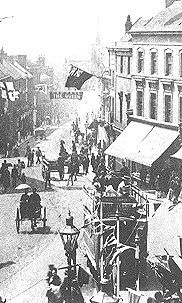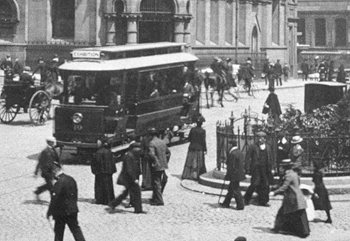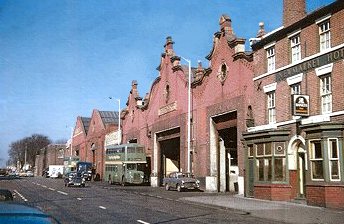Wulfrunians spent the final year of the twentieth century waiting for the Metro to introduce electric rail-borne passenger transport to their streets - exactly as they did in the first year of the twentieth century! Funny how History repeats itself.
The line to Tettenhall was the first to be completed and opened, although "Tettenhall" in this case really meant "Newbridge" - just within the Borough boundary. The line was constructed to the railway standard gauge of 4ft 8 1/2". The company established its headquarters and first depot near the foot of Darlington Street. The line passed its official inspection on 30th April 1878 and the following day horse-drawn trams entered public service. Wolverhampton's first tram left Queen Square at 8.00. am on 1st May 1878. The crowds turned out to watch this happen or to part with 2d for the fare for the twelve minute journey down to Newbridge. A single horse could pull a tram carrying 18 or 20 passengers but two horses were required when it came to the ascent of Darlington Street on the return journey. Two horses are often seen at work in surviving photographs, particularly when double deck cars were introduced. The routes to Willenhall and Bilston opened soon afterwards and Wolverhampton was firmly on the tramway map. Within a year a horse-drawn tramway was being planned to link Wolverhampton to Dudley, via Sedgley.
The use of such new technology created several delays in introducing steam traction - compare with today's problems on the Metro! - and it took about five months to sort everything out. The steam tram locomotive had arrived in December 1880 but did not enter service until 17th May 1881. The experiment was successful and the travelling public petitioned to have the steam service continue, but the Council refused to grant permission for this to happen! Travellers on the line to Dudley were more fortunate and the Council eventually permitted the use of steam power on that route in 1886, providing a speed of 8 mph was not exceeded within the Borough boundary. It was pretty clear that the Council could just about tolerate the emission of smoke in Blakenhall, but clean air had to prevail on the Tettenhall Road. In 1899 the Wolverhampton Corporation sought and gained powers to take possession of the tramways, to reconstruct and extend them, convert them to 3' 6" gauge and to electrify them using the overhead current collection system. The Council took this move for a number of reasons - one of which was a kind of feud that had developed with the British Electric Traction Company, who had acquired the Dudley line and had ambitions to bring electric tramways to all parts of the Black Country. The tramways became the province of the newly created Wolverhampton Corporation Tramways Department on 1st May 1900, and a number of improvements were initiated straight away - but the services were still horse-worked. As stated earlier, the century began with a long and troubled wait for the electric trams to arrive. One of the problems centred on the question of how best to supply current to the trams.
The end result of all this was that Wolverhampton adopted a very unusual system in which electric current reached the tram's motor via a skate, placed beneath the tram, making contact with studs placed between the running rails on the surface of the road. Opinions were very fiercely divided concerning the efficiency and safety of this system. Just as opponents of the Metro write passionate letters to the local press today, Wulfrunians fought an endless war of words over the electrification of the town's tramways in the 1900s. The legendary tales of horses being electrocuted in the streets of Wolverhampton are still recited even today! 1900 and 1901 passed while this debate continued, and work began on electrification before the dispute was resolved.
A new centralised depot was being built in Cleveland Road and the first stage of tramway electrification would be a line from Cleveland Road, through the town centre, to Waterloo Road and thence to New Hampton Road, within a short walk from the park. Working on this route first, and extending it to Newbridge, would provide a service into town for important Tettenhall passengers while the existing horse-tram line on Tettenhall Road itself was gauge-converted and electrified, as well as providing a service to the Exhibition in West Park. A mile of track using the Lorain stud-contact system was brought into use on 13th January 1902 between the Cleveland Road Depot and the Ettingshall Road. This provided Wulfrunians with a mouth-watering glimpse of their new electric passenger transport system, but as we know from our experience with the Metro, the first sight of a tram is often followed by a long and nervous wait! The public were first allowed to take a trip along this stretch of track a month later.
Ironically, Alderman Charles Mander, who had so opposed overhead wires appearing in Wolverhampton streets twenty years earlier, now had to propose conversion to that system. It was still a matter of bitter debate, and the Council took five and a half hours of wrangling before accepting the Tramways Committee's proposal. Poles were planted and wires strung up and the first tram taking its power from the overhead wire commenced work on the Dudley Road on 26th March 1921. Yet, by the end of that decade the trams had gone: the last tram to run in Wolverhampton for seventy years ran on 26th August 1928. Trams were replaced by trolley buses and motor buses - and that's another story. |








